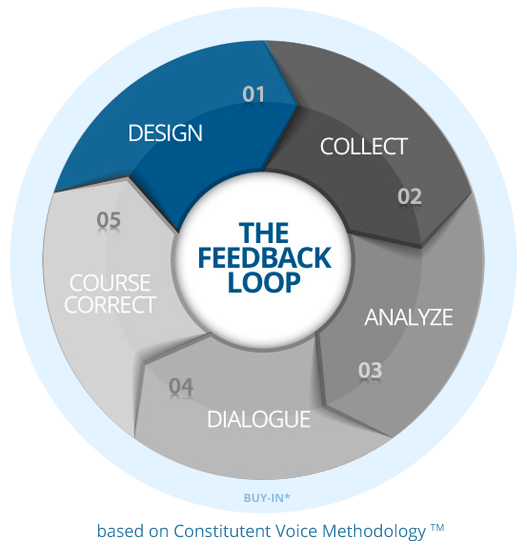
Welcome to Feedback Fundamentals. In this series, we’ll be getting back to the basics and highlighting what it means to “close the loop.” Whether you’re well versed in the jargon or new to the feedback community, this series will introduce you to ideas, frameworks, tools and approaches that we believe are essential for a strong feedback practice. Feedback Fundamentals is all about building a strong foundation and realizing a vision of listening to the people you seek to serve.

Feedback Fundamentals is all about building a strong core and realizing a vision of listening to the people you seek to serve.
In the previous article, we examined buy-in — the process of building support for your feedback initiative among the people who will give and use the feedback data you collect. In this article, we examine design.
Design is having a moment. There is an increasing variety of resources, tools and organizations out there to help you better design your programs and projects. But what does design mean as the second step in a closed feedback loop?
In a feedback context, the design step is when you create the plan for the rest of your feedback loop. Buy-in is focused on asking yourself questions about Who and Why, and then acting on your answers to create support for your feedback initiative. Who needs to use the feedback you collect? Why will they want to use it? Who needs to give you feedback? Why will they want to give it? The design step of a closed feedback loop focused on What, When, Where, and How. How will I collect feedback? When and Where will I collect it? What analysis will I do on the feedback I collect? How will I engage in dialogue with the people whose feedback I collect to better understand what they’re saying to me? How will I course correct? These are just some of the questions you will tackle in the design step.
If that sounds overwhelming, don’t panic. This is where the image of the feedback loop becomes incredibly useful. For each step of the loop, ask yourself:
- What am I going to do for this step?
- When will I do it?
- Where will I do it?
- How will I do it?
At first, you might sketch out some rough answers to these questions on a piece of paper. You might ask some trusted colleagues to critique your answers and then refine them. You might ask some of the people from whom you will be collecting feedback what they think of your plans, then adjust those plans. And so on and so forth. The key to the design step is to iterate on your plans, incorporating ideas and feedback from the people who will help you close the feedback loop, the people from whom you will collect the feedback, and the people who will ultimately use the feedback you collect in their decision-making.
At the heart of good design is understanding your ‘users’ – the people you are trying to help with your project – and the problem you are helping those people solve.
In a feedback context, that means understanding who is going to be using the feedback you collect, and what they will use it for. It also means understanding who is going to give you the feedback and what will make the process constructive for them. Those two groups in particular should have good opportunities for input as you create your plans in the design step. Make sure to step away from your computer and talk to real people!
Being part of the design step can be empowering for the people you seek to serve and the people from whom you plan to collect feedback. It’s also important to think about technology. Technology can enable the steps you’re designing, but can be tricky to leverage. You want to design with your users in mind, with the abilities of the technology you’ll use in mind, and understand the human capacity your organization will need to both use technology and meet the needs of your users. Members of the Feedback Labs network, like SIMLab, can help you plan to make the most of technology in the design step.
With a strong design step you set yourself up for the remaining steps in your feedback loop to go more smoothly. It’s worth investing time, effort, and energy to iterate in this step. Focus on What, When, Where and How, and you’ll be on the right track!
Next up: We enter the wild world of feedback collection.







